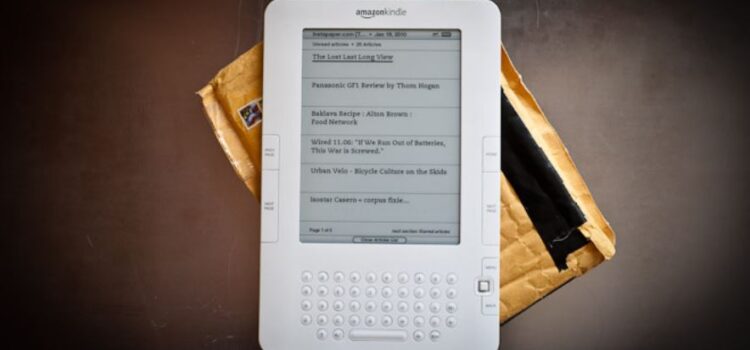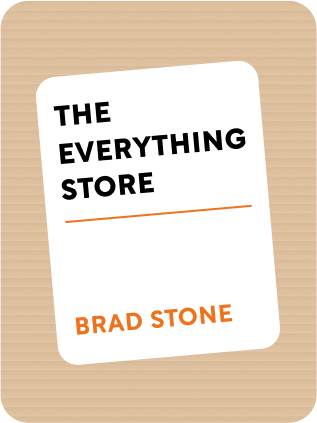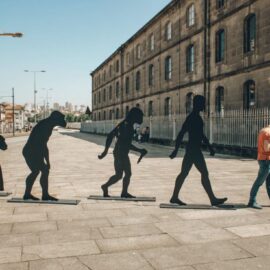

This article is an excerpt from the Shortform book guide to "The Everything Store" by Brad Stone. Shortform has the world's best summaries and analyses of books you should be reading.
Like this article? Sign up for a free trial here .
How did Bezos predict the launch of the first Kindle in 1999? Did the creation of the first Kindle go smoothly? Why were book publishers upset about the Kindle?
Although the first Kindle wasn’t released until 2007, Bezos predicted the Kindle in 1999 and Lab126 had started building it in 2004. In just a few short years, Kindle came to own 90% of the digital reading market, but book publishers weren’t too happy.
Keep reading to learn about the history of Amazon’s first Kindle.
Bezos Predicts the Kindle in 1999
Fall 1999: Amazon introduces the home and kitchen category. Employees remember kitchen knives flying down the conveyor chutes.
- (Shortform note: former Amazon engineer Steve Yegge wrote that in 1999 Bezos told the company that Amazon was dying. “all we sold were books, music and video, and all of them were being digitized and would die soon. Right then and there he predicted the Kindle and iTunes and Amazon Instant Video, none of which emerged until years later. He said that if we didn’t get into hardlines and other businesses, we’d be dead in a few years. He told us we had to be able to sell and ship anything, a live elephant if need be.”)
Lab126 Creates the Kindle
2004: Amazon creates a skunkworks group called Lab126. The mission is to disrupt Amazon’s retail business with an e-book device.
- Brief history of e-readers: In 1997, makers of e-reader Rocketbook (including later Tesla co-founder Martin Eberhard) approaches Amazon for funding. Bezos is impressed but wants exclusivity, to prevent rivals from stealing the future of reading. Parent company NuvoMedia balks and goes to Barnes & Noble instead.
- They sell thousands of devices but tank in the dotcom bubble. It’s said that Rocketbook and other e-books failed because they were ahead of their time. Another contributor to the failure is NuvoMedia selling to Gemstar, which had little interest in developing the devices.
- A picture of the Rocketbook:
- Another motivation for developing an e-reader: In 2003, Apple introduces the iTunes music store, which catapults past Tower Records, Amazon, and Walmart to become the top music retailer in the US.
- Jobs and Amazon had previously discussed a possible partnership where Amazon would sell music to iPod owners, but Jobs insisted on desktop software to provide a seamless experience from purchasing to listening on the player.
- Bezos at first dismisses iTunes, noting that 99 cent songs are unprofitable and used only to increase iPod sales. But as the iPod becomes ubiquitous, Apple owns the digital music retail and starts to explore other digital media like video, and Amazon gets worried.
- Amazon eventually introduces the MP3 store in 2007 with DRM-free music, but Apple negotiates the same agreements and Amazon never catches up in music. People in Amazon attribute their delay in music to Bezos’s complete lack of interest in music, compared to Steve Jobs’s devotion to it. (Bezos loves books far more than music.)
- Now in 2004, Amazon has 74% of sales coming from books, music, and movies. If these transition to digital, Amazon needs to protect itself. It must own e-books the same way Apple controls digital music.
- Bezos declares the new project to build a reading device. Employees are concerned – they had never done hardware before. Bezos dismisses these objections, wanting to control the entire end-to-end experience, as Apple did with the iPod. “We are going to hire our way to having the talent. I absolutely know it’s very hard. We’ll learn how to do it.”
- Bezos appoints Steve Kessel head of the effort, stripping him of his responsibilities in physical book sales. “If you are running both businesses you will never go after the digital opportunity with tenacity. I want you to proceed as if your goal is to put everyone selling physical books out of a job.”
- Bezos has specific objectives in mind:
- Guiding persona: “I’m going to the airport. I need a book to read. I want to enter it into the device and download it right there from my car.”
- A designer says “But you can’t do that.” Bezos: “I’ll decide what I can do. I’ll figure this out and it is not going to be a business model you understand. You are the designers, I want you to design this and I’ll think about the business model.”
- “Kindle has to get out of the way and disappear so you can enter the author’s world.”
- This presents hardware challenges like requiring a physical keyboard and cellular access.
- Guiding persona: “I’m going to the airport. I need a book to read. I want to enter it into the device and download it right there from my car.”
- Bezos wants 100,000 digital titles, with 90% of the NYT bestsellers list.
- Amazon is already in hot water with publishers, leveraging its size to squeeze lower prices from publishers. If any publishers refuse, Amazon shuts off recommendation algorithms for its books and promoting competitors’, cutting sales by up to 40%. Panicked authors then call their agents and publishers. Bezos calls this the Gazelle Project, like a cheetah pursuing a sickly gazelle.
- With the failure of e-books years ago, many publishers are loath to commit to digitizing their books. In music, record labels made the jump to digital because they had to deal with the relentless piracy problem. Book publishers don’t have the same problem. However, some publishers recognize the instant gratification possibility of the Kindle store.
- Amazon execs continuously yell at publishers for not digitizing books quickly enough, trying to meet Bezos’s 100,000 library goal.
- The development work continues from here into 2007, when the Kindle launches.
The First Kindle Launches in 2007
November 2007: Bezos introduces the Kindle at a press event, after 3 years of development in Lab126.
- He releases a bombshell: digital versions of books will cost $9.99. He models this after Apple’s 99-cent iTunes song, believing that customers expect to pay less for a non-physical book.
- Publishers are blindsided, not having known about the price beforehand. They feel betrayed, after having partnered with Amazon to digitize their books for months. Physical retailers are scared, believing that customers will abandon physical books for e-books.
- Rightly, they fear Amazon will accrue even more negotiating leverage.
Book Publishers Reject Kindle
Fall 2009: Two years after the Kindle releases, Amazon commands 90% of the digital reading market and releases the Kindle 2. Publishers are terrified.
- Any publisher that doesn’t follow Amazon’s pricing terms gets cut off in product listings, its wares becoming available only through third-party sellers.
- Two major publishers try to delay e-book releases until months after the hardcover versions come out. Consumers react poorly, giving these titles poor reviews on Amazon. Even without Amazon exerting explicit pressure, its status as the central shopping destination is unbeatable leverage.
- Amazon is experimenting with allowing authors to self-publish their works in Kindle, giving them 70% royalty on sales. Amazon has control over so much of the chain that it can cut out publishers entirely.
- In response to all this, 5 major publishing houses representing a large fraction of books sold – Penguin, Hachette, Macmillan, HarperCollins, and Simon and Schuster – collude with Apple to address Amazon’s $9.99 problem.
- They agree to switch to an agency model, wherein publishers would become retailers and set their own prices (between $13-15) and Apple would act as the broker and get a 30% commission. Apple receives a guarantee that other retailers wouldn’t undercut it on e-book prices.
- In Jan 2010, Apple introduces the iPad and the new e-books.
- Amazon’s countermoves:
- In response, Amazon blocks Macmillan books for a weekend. This attracts the ire of press and customers – directed toward Amazon – and they reluctantly reverse.
- Ironically, the pricing collusion actually raises Kindle profits, since Amazon holds most of the e-book sales and is forced to charge more for e-books. Amazon takes advantage by lowering Kindle device prices to as low as $79.
- Amazon approaches smaller publishers, warning they have insufficient leverage to pull the same move, and threatening to stop carrying their books if they tried.
- Amazon sends a white paper to the FTC and DOJ suggesting there was an illegal conspiracy. The DOJ sues 3 years later, in 2012.
- Fall 2012: Bezos unveils a new line of Kindle Fire tablets and the Kindle Paperwhite.

———End of Preview———
Like what you just read? Read the rest of the world's best book summary and analysis of Brad Stone's "The Everything Store" at Shortform .
Here's what you'll find in our full The Everything Store summary :
- How Amazon went from an online bookstore to the largest internet retailer in the world
- What Jeff Bezos did to compete with companies like eBay, Zappos, and Diapers.com
- What it was like to work for Jeff Bezos






